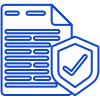The Robotic Process Automation (RPA) industry is growing exponentially with a growing number of applications in organizations across several industries. Forrester predicts it will grow from $250 million in 2016 to $2.9billion in 2021. Many businesses are turning to RPA to automate several commercial functions – processes with highly repetitive, data-intensive tasks that are rule-based are excellent candidates for RPA automation.
Adopting RPA can reduce manual effort for repetitive tasks by nearly 80% in commercial processes such as sales, marketing and Customer Relationship Management (CRM). While RPA can automate several tasks, it can be supplemented with AI to process unstructured data if required. This combination of AI and RPA is Intelligent Process Automation (IPA). Leveraging this type of intelligent automation enables hyperautomation of processes which provides several benefits – faster turnaround time, lower operational costs, greater accuracy and greater throughput. By 2022, 59% of business processes will be automated. Employees can lean on RPA to handle routine tasks while they focus on higher-value activities for the business.
Here’s a more in-depth look at the range of use cases for RPA automation in commercial functions.
- Marketing
Nurturing leads is a crucial task since it is directly responsible for the volume of leads received at the top of the funnel. These leads flow in from multiple sources like Linkedin, lead collection forms and sometimes, vendors. Automating this aspect of marketing activities with RPA or IPA (if there are heterogeneous data formats) can eliminate manual effort, accelerate processes and lower operational costs, while providing a steady flow of leads that can be potentially converted. This automation enables instant follow-ups with leads.
- Sales
Hyperautomation of several sales processes frees sales reps from tedious data entry and retrieval, enabling them to focus on responding to prospects faster and closing deals.
Creating & delivering invoices is a simple case of data entry and calculation. The same data has to be present in both accounting systems and the CRM. Instead of error-prone manual effort, bots can update accounting records, prepare and send out invoices directly through email.
Updating the CRM with customer interactions is a time-consuming process that must be completed as a company’s CRM is the final source of truth regarding any engagement. Instead of sales professionals spending hours on this task, RPA can be programmed to integrate business emails, calls and any other form of communication data with the CRM system. This way all updates are completed automatically.
Updating scorecards is important to maintaining employee-company rapport. Businesses that do not have a bridge between HR and CRM systems can deploy bots to make sure changes in the CRM are updated on sales rep scorecards in real time. Sales reps can view progress in real-time – this boosts morale and allows employees the insight to make improvements.
- Customer Relationship Management
Customer contact points function by accessing a number of disparate systems that are retrieved from multiple vendors. With sales reps scrambling to draw out data from various sources, customers are left waiting. Such an activity can be automated with bots, written to consolidate several pieces of data from across systems. Hyperautomation of processes minimizes manual effort ensuring greater operational efficiency and lower operational costs.
Loading customer profiles along with any and all previously completed interactions. RPA bots can retrieve detailed customer profiles quickly. This enables sales rep to create better customer experiences with all their previous transaction details and more.
Updating user preferences & other details by implementing RPA bots to pick up user preference data from disparate sources – email, customer service notes, data via chatbots, etc. and update your CRM. IPA can be used to handle unstructured content and myriad formats if required.
Getting detailed billing data while dealing with any customer issues can speed up the process and improve experiences for all those involved. If an RPA bot has been assigned to retrieve the data, the sales rep can access it with a single click instead of manually hunting through the CRM.
Resolving common customer issues for instance resetting a broadband connection with the server for a consumer can resolve a few minor connectivity issues. A simple RPA bot can be assigned to complete this without service reps switching screens.
Automating multi-step complex tasks that require little decision making can eliminate legacy systems used by customer service to complete several common tasks. As long as the decision is repetitive and rule-based, it can be easily automated. This saves your enterprise time and money.
Aside from commercial functions that can benefit from RPA, you can also consider using RPA in other areas of your business. Check out these 9 areas that are adopting intelligent automation for typical business processes.
If you’d like to explore avenues where your business can benefit from commercial RPA and IPA implementations for hyperautomation, the Rapid Acceleration Partners team would be glad to help. Our next-gen, AI-powered content intelligence platform RAPFlow enables full lifecycle AI orchestration on a single platform. When used in tandem with our RPA solution RAPBot, it provides end-to-end workflow automation capabilities that can be deployed in just weeks. You can even build your own use case and the platform can easily integrate with your existing systems. Book a demo to get a more detailed understanding of how our products can transform your business.










